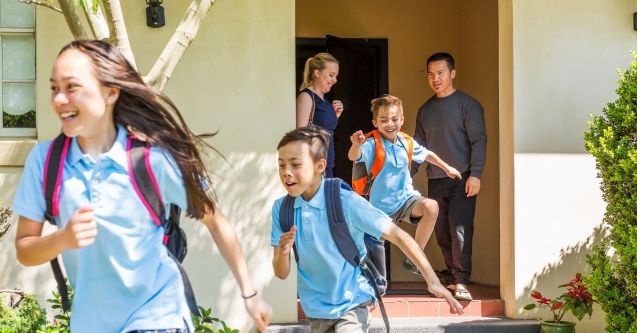Back to school - some tips and tricks to ease the stress
18 January 2023

It’s almost back-to-school time for the kids, which means the pressure of school expenses will begin weighing down on families across the country.
In 2022, 65% of parents found it challenging to meet back-to-school expenses for their kids. With an expected total spend of over $11.4 billion on back-to-school costs in 2023, including tuition, school supplies and other costs, more families already grappling with the cost of living crisis are facing the crunch.
Every parent wants the best for their kids, which is why school expenses can cause a lot of stress on the household. With many families resorting to Buy Now Pay Later options or paying in instalments to take the sting out of back-to-school costs, others are taking advantage of the option to buy second-hand or use hand-me-downs to minimise costs.
With a little preparation and planning, you can use our back-to-school budget tips to ease the financial burden and give your little ones a great start to the new year. You’ll need to do some homework first, but it’s worth it! Scroll down for some helpful tips and tricks for back-to-school success.
Back-to-school shopping tips:
School uniforms
- Put off buying warmer clothes until the seasons change. Buy only what you need at the start of the year and wait until the cooler weather before buying winter uniforms. This will give you time to save.
- See if your school has a uniform clothing pool or second-hand shop. Chat with parents who have older children at your school and see if they have any second-hand items available. Scour Facebook groups for your local area sales.
- Don't buy a uniform for every day of the week; buy a few full sets and commit to doing the washing more often.
- Label all clothing with your kid’s name; it helps make sure things get returned to you if kids lose them.
- Buy clothes one size bigger to make the uniform last longer. Buy shoes half a size bigger.
Stationery and supplies
- Re-use stationery and supplies you already have.
- Stick to your list and your price limit when shopping.
- Start shopping early to avoid the queues and get what you need.
- Aim for less expensive but durable stationery supplies that will last. Shop at discount stores, supermarkets or bulk stationery stores.
- Shop alone (if you can) as you won’t pay much attention to brand names or the latest action hero-themed supplies. Bringing your kids along may result in you spending way more.
- Shop year-round for things that you know you (or your child) will need for the upcoming school year.
- Replace the expensive, trendy notebooks and bags with generic brands and have your kids design and decorate them with their art.
- Label everything your child takes to school – it will save you in the long run as the items will come back to you faster if they get lost.
Things you shouldn’t scrimp on:
- Bags and shoes – If you can afford it, try to look for a durable one that will last many years. Consider versatile sneakers that suit school and sport, or inexpensive, quality leather without the brand name.
- Technology – Try to avoid upgrading to the newest. Consider second-hand options. Several outlets sell pre-owned or refurbished computers, laptops and tablets. If you do need a new computer, buy something with sufficient memory that meets your requirements and will allow for software upgrades (requiring greater memory) in the future.
Extracurricular activities
- Work out what’s important as a family – Ask whether spending your time and money is in line with the life you are trying to create with your family. If you want your child to build social skills, then activities with their friends may be the way to go. The point is deciding what’s important to you and your family, and then spending intentionally.
- Build bright lines – Create clear rules, e.g., each child can only be involved in one extra-curricular activity per term. By limiting choices, you provide children with an opportunity to focus on what they’re most interested in, and it also helps them take ownership and feel more dedicated to what they’re doing.
- Affordable alternatives – Look for cheaper alternatives at your local church or community centre. If possible, ask family members to purchase sporting equipment or lessons as a birthday or holiday gift.
- On-your-own-terms no – If you simply can’t afford a school expense, consider an ‘on-your-own-terms’ no. That might mean offering an alternative, such as a sleepover in place of an expensive excursion. Or you might have to tell a teacher or administrator ‘no’. Try hiking or educational walks as a family activity.
Government assistance with school costs
Some states offer assistance programs to help parents manage extra costs for school. Check out the Victorian government’s webpage for assistance and the Canstar school subsidies and rebates page for what’s available in your state.
Back-to-school budget tips
It is always beneficial to create a budget and work out your school expenses. Ensure you include extra costs that might come up during the year, e.g., excursions, project supplies, sports fees, school photos, fundraisers, etc.
- Pick your battles – Aim to save on bigger-ticket items such as computers and other electronics. Saving $300 on your high schooler’s new laptop means more to your budget than saving 50 cents on a bottle of glitter glue. Focus on saving money on your biggest expenses first.
- The power of persistence – There’s power in monitoring your spending on the small stuff, like school supplies, groceries, and clothing. Over time you can significantly increase in your overall savings.
- Work it out with your kids – If your kids are older, agree on a budget so they can choose what they get and help develop a sense of financial needs and priorities. Talk to your kids and find out what’s important to them. As parents, we often forget that our kids’ expectations may be very different from our own.
For the greatest impact, consider slowing down your back-to-school shopping so that your child can experience the process of budgeting. Allow your kids the freedom to make their own spending decisions. Be prepared to have an open discussion after they’ve made their purchases and before their next trip to the store.
Healthy habits
Back to school also brings a new start, with the chance to start new routines and healthy habits as a family.
- Walk to school – If you have primary school-aged kids and live within walking distance, see if your school has a walking school bus. This fun and safe way to get to school involves a group of primary school children walking to and from school with two adults, one 'driving' and one at the back. Other options to consider are public transport (more efficient and has lower costs than individual car travel) or carpooling with other parents.
- Packing lunch – If you only give your child lunch money once a week rather than every day, you can save more than $1,000 over the school year (assuming lunch costs $7). Packing a healthy, enticing lunch in a hurry 5 days a week can be a challenge and pre-packaged snack items might seem easier, but these come at an environmental and financial cost. Invest in a few re-usable, sealable containers or replace packaged snack foods with fruit. Try using a stainless-steel drink bottle.
- Get kids involved in choosing their lunch and mix it up—they'll be more likely to eat it than not. Look for a durable lunchbox, and one with separate compartments for different food items, eliminating the need for individual wrapping.
- Pocket money – Pocket money is a great way to help kids develop money skills for the first time and allows them to practice goal setting and financial independence. Be sure to set some guidelines when giving pocket money to your kids and explain to them what their money can and can’t be used for. A helpful guideline is using a three-jar system for young children - one jar for saving, one for spending money and one for donations. Children can put some of their pocket money each week in each jar.
- Meal planning – Make sure food for the week is purchased on the weekend, so you’re not dashing off to the shops during the week or paying more at a convenience store. You can also set aside time on Sunday to prepare two or more meals so that you are just reheating on the night when they are required. To reduce waste (and wasted money too), plan to use leftovers.
Additional resources you can check out:
• Moneysmart – Reducing back-to-school costs
• Simple back-to-school budget calculator
• The Salvation Army Financial Assistance page
